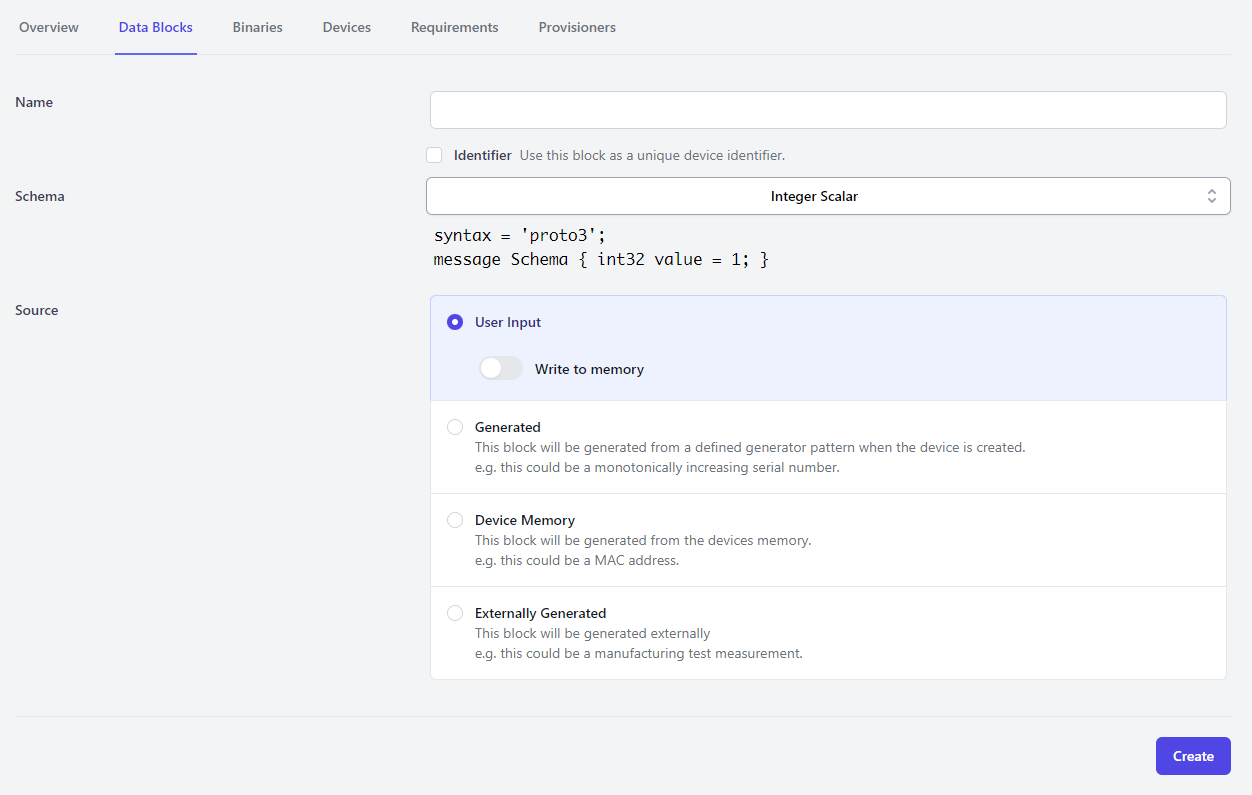Data Blocks
Data blocks describe what data is associated with your device. This encompasses input parameters, test measurements, configuration parameters, and automatically derived values.
Data can only be associated with a device once a block has been created that describes the data.
Creating Data Blocks

When you create a new data block, you will be prompted for four pieces of information, outlined below:
- What is the name of the data block being created
- Is the block a representation of the unique device identifier
- What is the schema of the data represented?
- What is the source of the data?
Identifier Blocks
One data block may be marked as the "Identifier". In this case, the value associated with the block will be used for display purposes in the "Devices" pane. Often, the "Identifier" should be the device serial number or other unique value to differentiate between devices.
The identifier can be selected for any data block, but only one data block may be marked as the identifier. If a new block is selected as the identifier, any previous identifier selection will be erased.
Block Schemas
The "Schema" associated with the block outlines the specific format of data within the block. The "Schema" is used for serialization and deserialization of the data contained within the block.
The following schemas are available:
| Name | Description | Example |
|---|---|---|
| Integer Scalar | A single integer value. | For example, this could be the number of outputs installed on a unit. |
| Float Scalar | A single real number. | For example, this could represent the measured device supply voltage during testing. |
| String Scalar | A single string. | This could be the human-readable serial number of the device. |
| Float Array | A sequence of real numbers. | This could be a series of voltage measurements taken on an output waveform from the device during testing. |
| Integer Array | A sequence of integer values. | This could be a configuration parameter for all of the output channels of a device. |
Block (De)Serialization
Serialization and deserialization are transformations on the data block to convert it between human-readable and binary representations. The serialization and deserialization process utilizes protobuf3 specifications.
When the block is written to device memory, the data block must be serialized. This process occurs immediately when the data block is uploaded to forged.dev.
Deserialization is completed when displaying data blocks on the "Devices" pane in the forged.dev UI.
Block Sources
Blocks may have a number of sources, which means where the data comes from.
The following sources are supported.
| Source | Description |
|---|---|
| User Input | The data is supplied by the operator at the start of the provisioning process. |
| Generated | The data is automatically generated when the provisioning process is started. |
| Device Memory | The data is collected by reading non-volatile memory from the device during the provisioning process. |
| Externally Generated | The data is provided by an external, automated source (such as a manufacturing test) at any point during the provisioning process. |
The source specification impacts how the forged.dev provisioning UI interacts with your project.
Specifically:
User Inputblocks will be requested from the operator at the very start of the provisioning process.Device Memoryblocks will be read from the device towards the start of the provisioning process and automatically uploaded to forged.devGeneratedblocks will be automatically generated for the product and will be accessible to future steps of the provisioning process (i.e. manufacturing test scripts, provisioning scripts)Externally Generatedblocks are assumed to be provided by an external test script
Persisting Data to the Device
Data blocks can optionally be written into device flash as part of the programming procedure. This enables powerful functionality, such as the ability to automate device-specific calibration parameters to achieve necessary accuracy and tolerance parameters for your product.
Uploading Block Data during Provisioning
The forged provisioner supports reading block data from the device during provisioning time using the RTT (Real-Time Transfer) protocol. This can be useful, for example, when performing self-test measurements on the device for manufacturing or extracting device-specific serial numbers or keys.
If RTT is configured on a device, the provisioner UI will monitor RTT output for 1 second to acquire blocks (the 1 second timer resets whenever a block is encountered).
Data is extracted from the device RTT output using a basic raw text transfer format, making it easily interoperable with printf-like functions over RTT.
The format of block uploads via RTT is as follows:
forged>{block-name}:{block-value}\n
Below is an example of uploading a device-specific MAC address for the mac-address data block:
forged>mac-address:41-56-21-3f-ff-fa\n
The string 41-56-21-3f-ff-fa is then associated with the mac-address datablock for this device.
Uploading blocks via RTT is supported for all scalar data types, including strings, integers, and floating point numbers.